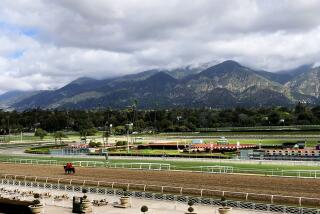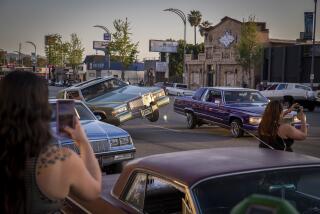Beercan Boat Races Tack to the Foamy Side
At two minutes before 6 p.m., the scene looks like some sort of above-water feeding frenzy.
Back and forth, in and out, the boats wheel and dart, often barely missing each other, tacking madly, jockeying furiously, slicing through a sea of shouts and curses, bearing their crews off in a relentless weekly pursuit of nautical glory and cold beer.
To the crews, the weekly Beercan Regattas are a fine madness. On every summer Thursday they sprint from their offices to their boats, climb out of business suits and into shorts and deck shoes, stock the holds with beer, raise the sails and take their places in the frantic traffic near the starting markers at the southeastern end of Newport Harbor.
Sponsored for more than 30 years by the Balboa Yacht Club, the Beercan Regattas have become synonymous with sailing--both sublime and ridiculous. On any Thursday evening during June, July and August, it isn’t unusual to see nearly 50 sleek boats, ranging in lengths from 20 to 50 feet, zigzagging their way upwind toward the western end of the main harbor channel, where they turn around a halfway marker. It is a simple out-and-back race that lasts a little more than an hour, but some skippers and crew members will say they measure their success as much by the amount of beer consumed as by their boat’s place in the standings.
The races are open to members of any yacht club whose vessels fall into one of eight racing classes, and there are trophies for the winners each month. But, said Bill Campbell, a staff commodore at the Balboa Yacht Club, “everybody’s out here mostly for fun. The trophies are really of secondary importance.”
Committee Boat
It is Campbell’s boat, the 56-foot power yacht “Sunshine,” that serves each week as the committee boat--a platform from which officials of the yacht club start the race. It is also a kind of floating home base around which the boats swarm before the start, often barely missing it as they tack, a maneuver that never fails to cause Mimi Glass, who is race chairman for the month of August, to cry out, “It’s bad form to hit the committee boat!”
It is not unusual, Glass said, for boats to collide in the mad whirl at the start markers. Many of the wounds are superficial, she said, and the boats sail on, but the skippers usually file a protest to the committee later. Most of the skippers are quite deft at avoiding competitors, although, occasionally, one boat “spears” another broadside with its bow, causing slight damage. No serious injuries have been reported.
The origins of the Beercan Regattas are vivid and murky, said Gordon Glass, a member of the race committee and Mimi’s husband. Exactly what year the races actually began no one seems to know, he said, but Glass remembers hearing of a pair of Newport Beach yachtsmen in the early 1950s “bragging about who had the fastest boat and betting a case of beer on a race. A week later some other guys heard about it and said, ‘That looks like fun,’ and it started to grow from there. In those days, though, you’d run what you brung. There were no limits on the type or size of the boats, and really no rules. The start looked like a demolition derby out there, especially when the wind really blew.”
By 1954, he said, sailors began to realize that “they were going to get hurt or sink something expensive if they didn’t get organized,” and the administration of the race was taken over by the Balboa Yacht Club.
Other Races
The Beercan Regattas have spun off other so-called “pickup” races in Southern California since they began. In Orange County, the South Shore Yacht Club, the Dana Point Yacht Club, the Capistrano Bay Yacht Club and the Bahia Corinthian Yacht Club all sponsor weekday evening races of the Beercan variety. But none, say area sailors, are as large or tradition-steeped as the original.
“This race is the granddaddy of its kind in this part of the world,” said Doug Wall, a member of the race committee. “It’s like the Rose Bowl.”
The freewheeling quality of the race has waned a bit from the maverick days when nearly anything went if you could get away with it, Campbell said.
“Guys would yell ‘starboard tack!’ (in an attempt to avert a collision) and you’d say, ‘So what?’ ” he said. Today, with high boat insurance rates and more stringent standardization of the rules of the road, reckless sailing has largely disappeared, he added.
Even water balloon fights between boats, a common sight in recent years, have faded somewhat as a result of more stringent race rules and discouragement by the Orange County Sheriff’s Harbor Patrol, Glass said.
Relaxed Contests
But the relaxed nature of the races, and the manner in which the crews live up to the regatta’s name, have remained.
“I’m afraid,” said Campbell, in the pose of man bemused by his wayward children, “that there’s quite a bit of drinking that goes on out there. I would say beer is indicative of what’s consumed on the ‘lighter side.’ ”
The “lighter side” is the return trip, after the boats have rounded the mark at the western end of the course and are sailing downwind. The boats are then sailing straight ahead and, because the wind is almost directly behind them, there is no need for fierce tacking or quick handling of lines and winches.
“That’s when the beer comes out,” Gordon Glass said. “This is one race where you just don’t care. So much of yacht racing is so deadly serious, but you can get out here and just take it easy.”
There are those, however, who race to win and save the elbow bending for the club bar afterward.
“About 75% of the people out here are having a good time and about 25% of us take it seriously,” said Bud Desenberg, 72, the skipper of the 28-foot Sparrow Hawk. “I don’t think there’s anything relaxed about the Beercan. There’s a lot of excitement, a lot of action, and you have to dodge a lot of boats. It’s more exciting than offshore races because you have to tack so much. There are boats coming at you from all different directions. And the wind is variable. You have to adjust to it.”
Sudsy Sailing
For others, however, it is a very sudsy sail.
“This is the family boat, and we always have the most fun, the most girls and the most people on board,” said Craig Barto, 29, whose 43-foot sloop Driller finished first in its class on a recent Thursday. “The normal crew on this boat for racing is seven or eight,” he said, “but for the Beercan it’s about 25.”
Barto’s brother, Eric, called the race “serious fun. It’s a great release, something to look forward to. It’s really a tradition in the summer. We’re hard-core sailors and we’ve sailed to Hawaii and Cabo San Lucas, but this is the fun one.”
Gene Foster, crewing on Amante, which finished second behind Driller, called the race “good relaxation, but as far as being laid-back goes, it is and it isn’t. Everybody’s friends, but we’re also rivals. You have to have beer, though.”
Gordon Graham, 49, skipper of Contention, which finished second in its class, said facetiously that he sails in the Beercans for “the thrill of the start. Actually, it’s a good release for me after work. I just steer and the other guys on the crew grind.”
But perhaps the best description of the nature of the race was an oblique reference, by Desenberg, to his refusal to participate in Beercan Regatta tradition:
“We do not ,” he said with finality, “have hors d’oeuvres on our boat, and we do not have beer before the finish.”


